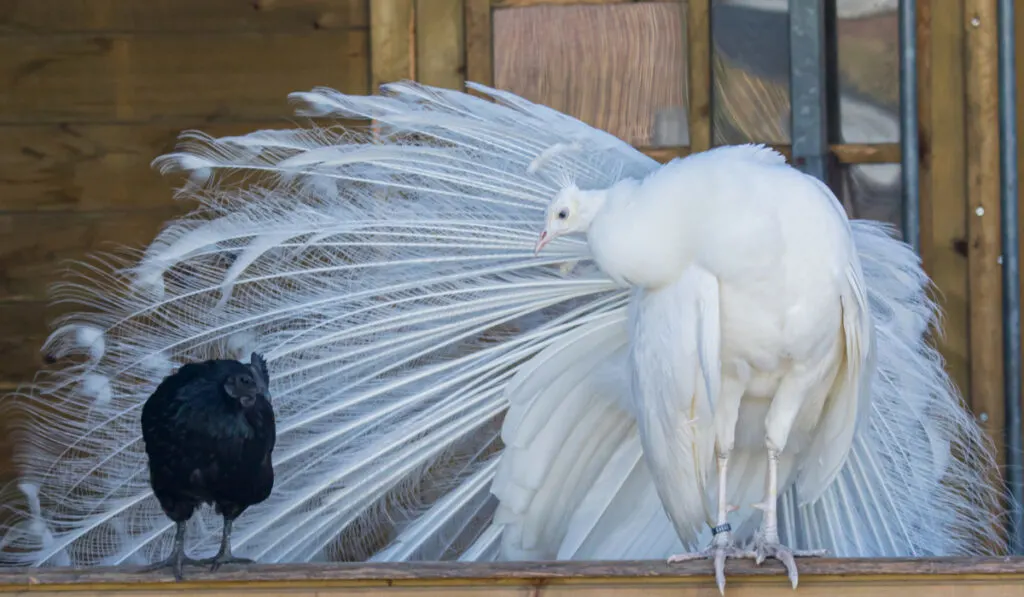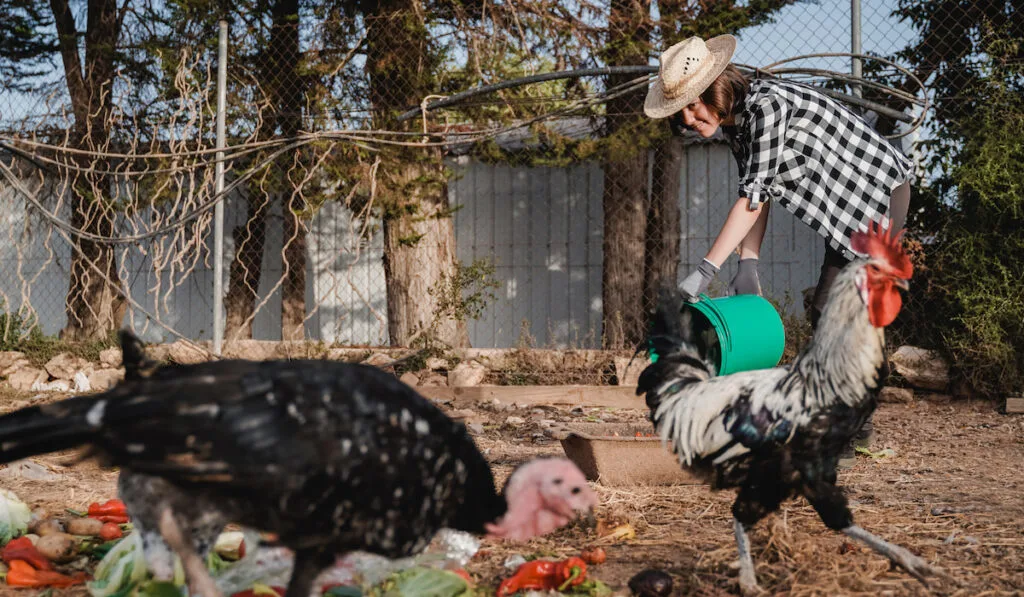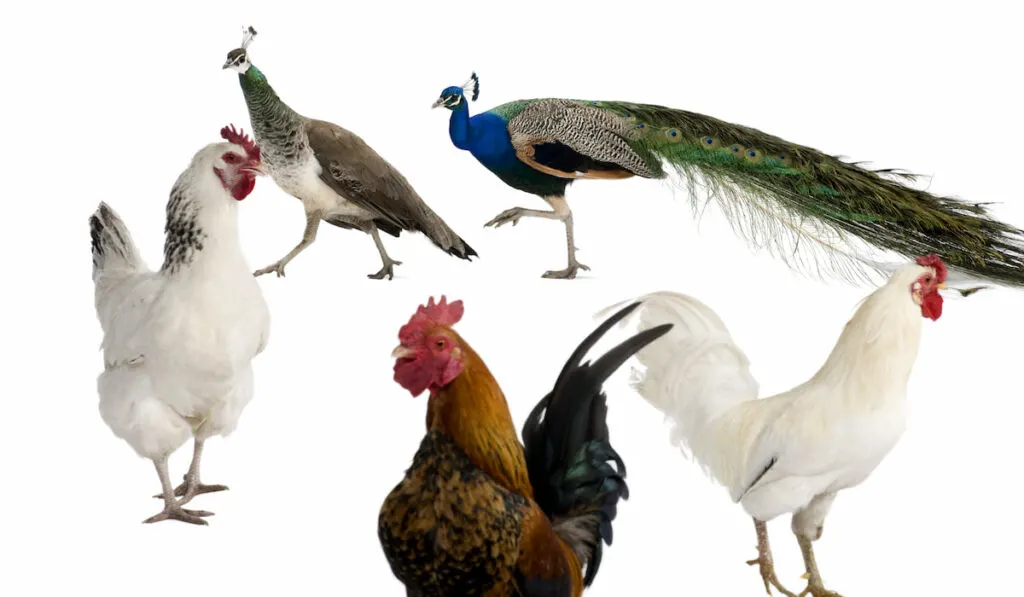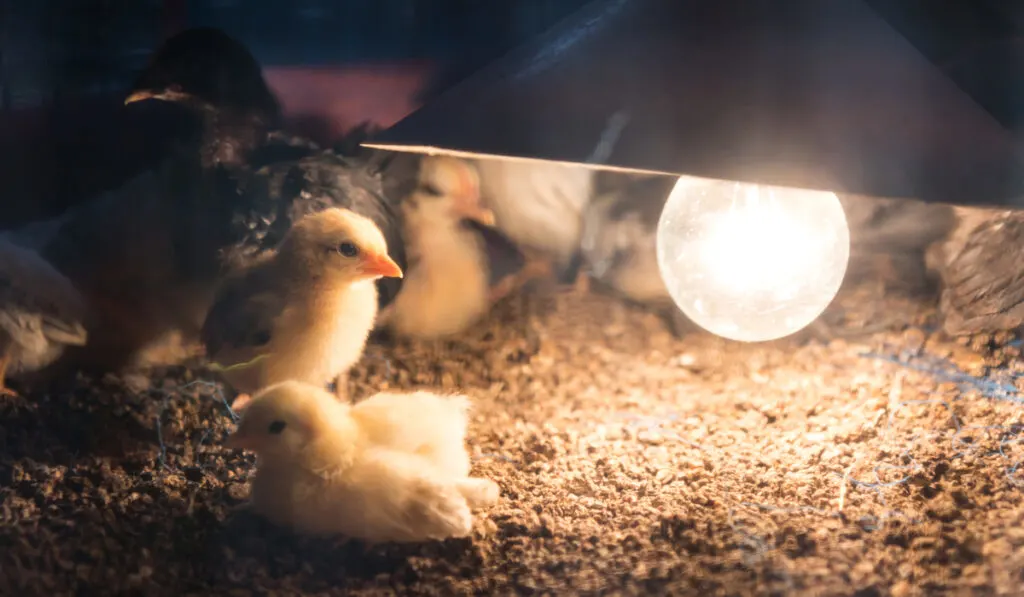Raising birds is easy and fun. It is a great experience to see your birds grow.
Whether you are raising chickens, ducks, turkeys, or peacocks, it is the same experience for every homesteader. Have you ever tried to raise different species of birds together?
For example, raising chickens and peacocks. Can you raise peacocks and chickens together?
Raising peacocks and chickens together is possible and even easier than raising chickens with other types of birds as peacocks are friendly.
However, you do have to provide separate feeds for your chickens and peacocks, as well as meet the different needs of your birds.
What do chickens and peacocks need? Can chickens and peacocks eat the same type of feed? Continue reading to find out.

Table of Contents
Raising Peacocks and Chickens Together
When raising multiple bird species, you need to make a lot of considerations. Some things that you should consider are:
Feed for Both Birds
While both birds can eat similar foods, it is important that you pay close attention to the protein content of their feed.
Protein is the most essential nutrient in feeds because your birds need proteins to grow meat and feathers, produce eggs, reproduce, repair and grow new tissues, etc.
The table below compares the crude protein content needs of chickens and peacocks:
| S/N | Age of Bird | Chicken Protein Crude Requirement | Peacock Protein Crude Requirement |
| 0-3 Weeks | 23% | 30% | |
| 3-6 Weeks | 20% | 28% | |
| 6-8 Weeks | 18% | 19-20% | |
| 8 Weeks > | 16-18% | 19% |
(Sources: Chicken,)
From the table above, you can see that peacocks require more proteins in their diet.
Peacock feed is usually more expensive than chicken feed, so feeding all your birds (both peacocks and chickens) with peacock feed will be a waste as the chickens do not need the higher amount of protein. It will also be more expensive for you.
Conversely, you should not feed all your birds with the less expensive chicken feed because your peacocks will not grow as fast as they should.
To provide the protein needs of your birds, you will need to give different feeds to your chickens and peacocks. You will also need to provide alternative feed sources.
Chicken feed is easy to get in various stores. You can search for peacock feed or a gamebird feed in feed mills and stores for your peacocks.
Alternative feed sources rich in proteins are:
Grains: Grains are rich in plant-based proteins. You should give your birds enough grains, especially in winter as grains can keep your birds warm.
You can also use grains to train your chickens and peacocks to return to their coop. Examples of grains are maize, wheat, oats, rye, etc.

Mealworms: Mealworms are the larvae of the mealworm beetle. Mealworms have a lot of protein (20% for fresh wet mealworms, 53% for dried mealworms) that can fill the protein needs of your chickens and peacocks.
Little Vertebrates and Invertebrates: If you allow your chickens and peacocks to search for their food (forage or free-range), they will eat several invertebrates including insects, earthworms, nematodes, and spiders. They will also search for vertebrates such as lizards, toads, frogs, etc.
It is also important that you pay attention to other nutrients such as vitamins and minerals.
While every nutrient need of your chickens and peacocks can be provided in their formulated feed, you should give your birds some fruits and vegetables.
Housing Chickens and Peacocks
Peacocks are special birds and need much more space than chickens. You can build a small coop or pen for your chickens, but peacocks need a much larger pen.
You need about 10 feet by 10 feet at least for peacocks (because of their train).
Chickens, however, do not need that much space (1-2 feet by 1-2 feet per chicken.)
If you like, you can raise chickens and peacocks in the same pen (a pen large enough for peacocks). Just make sure that you separate the chicken and peacock feed to avoid waste.
As you can see, it is possible to raise peacocks and chickens together when the conditions are right. However, there are some risks that you must consider.

Risks Involved in Raising Chickens and Peacocks Together
Here are some risks to consider:
1. Blackhead Disease
Histomoniasis or blackhead disease is a disease that affects various birds. It is caused by a protozoan called Histomonas meleagridis. This disease gets transmitted easily across various bird species. This means that your peacocks can spread blackhead disease to chickens (and vice versa).
Symptoms of the blackhead disease in birds include:
- Lethargy
- Inflamed liver
- Falling of wings
- Yellow droppings
- Depression of birds
You should isolate sick birds and call the vet immediately if you spot sick birds.
2. Fighting and Competition
Your birds can fight for feed and space when either is not available in enough quantity. To prevent your birds from fighting, make sure that there is sufficient feed and your birds have enough space to move about.
If there are males and females of both bird species, space should be much larger to avoid constant contact between both birds.
Now that you know the risks involved in raising peacocks and chickens together, you should also know that it is easier to raise peacocks and chickens when you start to raise them as chicks and peachicks.
Can you raise chicks and peachicks together in the same brooder box? Continue reading.
Brooding Chicks and Peachicks
It is possible to raise chicks and peachicks in the same brooder box because the principles and practices of brooding chicks and peachicks are the same.
However, you must note that peachicks are larger than chicks, so you’d need a large brooder box to accommodate both bird species.
It is your choice to brood the young of both bird species together or not. Since brooding both bird species operates the same way, you should know what you need.
Essential Items to Brood Chicks and Peachicks
Here are must-have items for brooding chicks and peachicks:
1. Brooder Box

The brooder box is essential. It should be large enough to allow movements of the young birds. The box should be draft-free and well-insulated. You can use a mini bathtub, children’s plastic pool, or other similar items as your brooder box.
2. Bedding
Bedding is very important. Bedding acts as an insulator, it absorbs moisture from bird poop and prevents the feet of the young birds from touching the cold ground. Some bedding ideas are:
- Hay
- Straw
- Paper
- Wood shavings
- Sawdust
In the first week of your birds, you should use newspaper or paper towels in the brooder box to prevent your chicks or peachicks from eating the bedding.
3. Feed
You should use starter chick feed for your chicks and starter gamebirds feed for your peachicks. Make sure that feed is always available for the chicks. Do not feed your chicks or peachicks with anything outside the recommendations of a vet or local expert.
4. Clean Water
The tip for giving water to birds is that “if you can’t drink it, don’t give it to your birds”.
Many bird diseases are water-borne, so you need to pay close attention to the quality of water that you give to your birds. Do not give water that has been exposed to the sun, wind, and other environmental factors for too long.
Remember to always wash your water troughs and drinkers.
5. Heat Lamps or Other Sources of Heat

Even though birds are endothermic and can generate their own body heat, they lack the ability to generate heat in their first weeks after hatching. This is why mother birds continue to brood their chicks for a few weeks after hatching.
If you want to brood your birds by yourself, you need to provide them with sufficient temperatures. The table below shows the temperature needs of peacocks and chickens.
| Age of Bird (Weeks) | Best Temperature for Chickens | Best Temperature for Peacocks |
| 0-1 | 92 °F | 95 °F |
| 1-2 | 87 °F | 90 °F |
| 2-3 | 82 °F | 85 °F |
| 3-4 | 77 °F | 75 °F |
| 4-5 | 72 °F > | Room Temperature |
| 5 and beyond | Room Temperature | Room Temperature |
From the table above, you can see that peacocks and chickens have similar temperature needs and can be in the same brooder box (if the temperature is all that you are considering).
The major source of heat for young birds in a brooder box is a heat lamp. Heat lamps can be adjusted to provide just the right temperature to your birds.
Remember that your brooder box should be draft-free.
Now you know how to brood chickens and peacocks, right?
Related Questions and Answers
Do you still have any questions? Here are some answers:
1. Can Peacocks Kill Chickens?
Peacocks are very friendly birds and they do not love fighting, unlike other bird species. When their needs (feed and space) are met, they will live peacefully with other birds.
However, peacocks have stronger beaks and claws than chickens, so they are more likely to win a fight against chickens.

2. How Do You Train Your Birds to Return to Their Coop?
You need grains, bugs, and other forms of treats to reward your birds as you train them. You should give treats to birds that return to the coop early. Doing so 2-3 days per week for the first 3 weeks after releasing your birds from their brooder box will encourage them to return to their coop.
You should continue to reward your birds afterward but do so occasionally, not regularly.
3. How Do You Know That Your Birds Are Ready to Leave the Brooder Box?
It takes 5-6 weeks for chickens and 7-9 weeks for peacocks on average to be fully matured and ready to leave the brooder box.
As a tip, your birds are ready to leave the brooder box when they are fully covered in feathers.
Have you found the answer to your question?
Final Thoughts
You can raise chickens and peacocks together so long as you provide enough food, space, and other needs. Remember to give your birds some tasty bugs as treats.
As for chicks and peachicks, it is possible to brood them together, but the choice is yours as you’d be needing a larger brooder box.
Resources
- https://link.springer.com/chapter/10.1007/978-3-030-32952-5_20
- https://animals.mom.com/build-peacock-coop-9191.html
- https://www.altdesign.com/poultry-chicks-brooding/
- https://chickenandchicksinfo.com/can-peacocks-live-with-chickens
- https://www.purelypoultry.com/blog/can-i-raise-chickens-and-turkeys-or-peafowl-together/
- https://aboutpeafowl.com/feeding-peacocks-and-peahens-peafowl-food-how-to-feed-peafowl-to-keep-the-birds-healthy/
